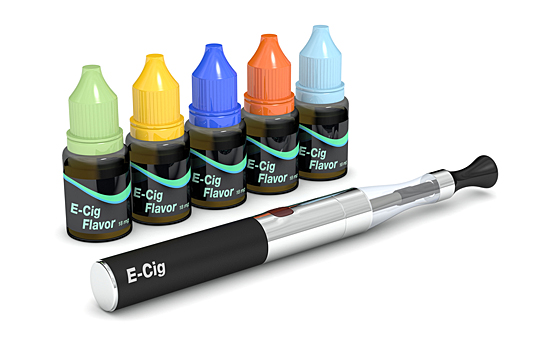Research published last week indicates that the number of children poisoned by the nicotine liquid found in e-cigarettes is skyrocketing. And new regulations announced recently by the Food and Drug Administration are aimed to help keep the devices out of the hands of kids.
Health experts at The University of Toledo also are urging parents to be vigilant in keeping electronic cigarettes out of the reach of young children.
 E-cigarettes are battery-operated devices that use cartridges of a liquid solution containing nicotine, flavorings and other chemicals that when heated create a vapor that is inhaled. They are marketed as a safer alternative to traditional tobacco cigarettes, but they come with their own risks. And the liquid is sold in a variety of colors and flavors, which can make it enticing to children.
E-cigarettes are battery-operated devices that use cartridges of a liquid solution containing nicotine, flavorings and other chemicals that when heated create a vapor that is inhaled. They are marketed as a safer alternative to traditional tobacco cigarettes, but they come with their own risks. And the liquid is sold in a variety of colors and flavors, which can make it enticing to children.
“Nicotine is ultimately a poison,” said Dr. Amy Thompson, UT associate professor of health education. “Flavorings and scents are added, making the vapor taste and smell like candy or other sweets, sparking the curiosity of children who then drink the fluid. Additionally, there have been instances of the batteries in e-cigarettes exploding, causing severe burns. E-cigarettes and nicotine liquids must be treated as any other controlled substance and kept away from the reach of children.”
National Poison Data System information published in the journal Pediatrics last week reveals the number of children accidentally ingesting liquid nicotine is growing with a nearly 1,500 percent increase in the number of children younger than the age of 6 being exposed to e-cigarette fluid during a 40-month study.
“A child who drinks the nicotine fluid could experience a rapid heartbeat, heavy breathing, pale skin, nausea and vomiting,” said Dr. Kristopher Brickman, professor and chair of UTMC’s Department of Emergency Medicine. “Even a small amount, as little as a couple sips, could have an effect on a young child.”
A related study indicates advertisements for e-cigarettes have contributed to an increase in older children starting to use the electronic devices. According to the 2014 National Youth Tobacco Survey, middle and high school students reported internet, magazine and newspaper, retail stores, and television advertising as a contributing factor to their decision to use e-cigarettes. As many as 2.4 million teens reported using e-cigarettes in 2014.
“The long-term effects of using e-cigarettes are not well-known at this point,” Brickman said. “Often the ingredients of the liquid are not listed, and are largely unregulated, so you just don’t know what you’re getting when you inhale this chemical. We do know that nicotine is extremely addictive and, unfortunately, e-cigarettes are packaged in such a way that is appealing to kids.”
In an effort to protect children and teens from the potential health risks associated with e-cigarettes, the Food and Drug Administration announced May 5 that it is extending its regulatory authority with new provisions aimed at restricting youth access to e-cigarettes. Those regulations include not allowing products to be sold to individuals younger than 18 years of age with proof of age required by photo ID; not permitting sales in vending machines; and not allowing the distribution of free samples. The new rules go into effect Aug. 9. The provision also allows the FDA the ability to review product design, ingredients and potential health risks, bringing them more closely in line with other tobacco products.
“The FDA regulation is a step in the right direction,” Thompson said. “The responsibility of keeping kids safe still lies with parents and adults who come in contact with children. Adults need to be vigilant in keeping e-cigarettes and nicotine fluid out of kids’ reach and talking to their teens about the dangers of becoming addicted to nicotine.”